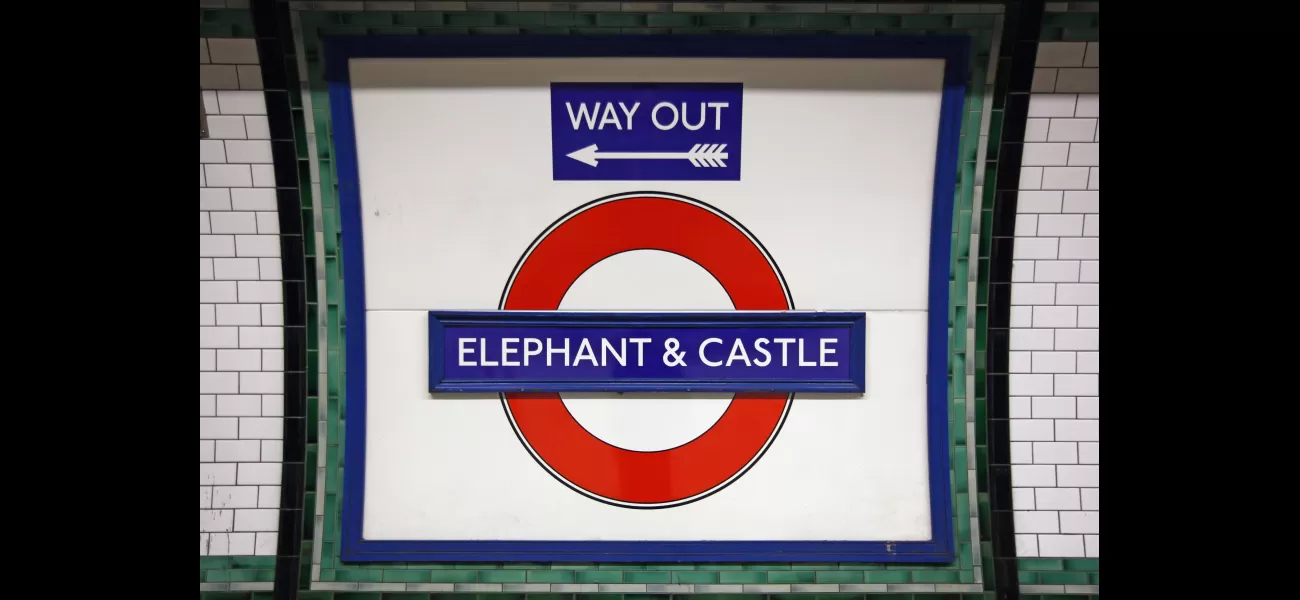Recently, the significance of London Underground station names has been uncovered.
The Tube's strange and fascinating station names.
June 10th 2024.

Have you ever stopped to think about how the weirdest stations in London got their unique names? As Londoners, we often consider the Tube to be our second home and take these quirky station names for granted. But have you ever found yourself waiting for a delayed train and staring blankly at an iconic Underground station sign, wondering about the story behind its name? Well, wonder no more! Let's take a look at the stories behind 11 of London's quirkiest stations.
First up, we have Swiss Cottage. Located in Camden, this station may bring to mind images of cheese or the Alps, but it's actually named after a pub - the Swiss Tavern. Built in 1840 in the charming Swiss cabin style, the pub was later renamed Ye Olde Swiss Cottage. However, the station's brutalist exterior is a far cry from the quaint cottage vibe of its namesake.
Next, we have Paddington, one of London's busiest transport hubs. With over 46 million passengers in 2022, this station is a gateway for National Rail trains heading west. Despite its association with the beloved Paddington Bear, the station's name actually predates the famous bear's birth in the mid-1950s. Historians believe it comes from a 10th-century Anglo-Saxon chief named Padda.
Moving on to Arsenal, located in Highbury in north London. This station was renamed in 1932 after the famous Arsenal Football Club. The original name, Gillespie Road, was replaced a few years before the start of World War II. This nod to the football club's links to the Royal Arsenal munition factory, where its founding members worked, makes perfect sense. After all, Arsenal means a collection of weapons, borrowed from medieval French and Italian.
Canary Wharf, one of the newer stations on the Tube network, serves the Jubilee Line, Docklands Light Railway, and Elizabeth Line. Although it may be a new addition, the name of the Canary Wharf docklands dates back to the late 1800s coal trade and later the shipping of bananas to and from the Canary Islands, as reported by the BBC. The word "canary" comes from Old Spanish, meaning "dogs," and became the name of the islands after the Spanish conquest.
Now let's take a look at Elephant & Castle, a station in Southwark that derives its name from the south London neighborhood. The area is named after a mid-1700s coaching inn, and there is evidence that there may have been a pub even earlier, as Shakespeare's play The Twelfth Night, written in 1601, mentions the "Elephant" in the area. However, it is more likely that the pub referred to in the play was located elsewhere, and the area's first pub was the Elephant on Bankside. The area may have been named after the medieval craftsmen of the Worshipful Company of Cutlers, whose crest features an elephant carrying a castle.
On to Cockfosters, a suburban station with a perfectly PC name that might cause some giggles upon first hearing it. But fear not, this station's name comes from the chief forester of the Enfield Chase estate, known as "the cock," since at least the 16th century.
West Ham, located in the London Borough of Newham, is simply named after the area it serves. However, the area's name has an interesting history, as it used to be part of an old Manor of Ham. "Ham" comes from the Old English word "hamm," meaning a dry patch of land between rivers and marshes - a fitting name for an area flanked by the Rivers Lea, Thames, and Roding.
Temple, although only opened in 1870, has a rich history dating back to the 12th century. Surrounding the Temple Church, the area has close links to knights and Crusades. The name "Temple" was first recorded as Novum Templum, meaning "New Temple," in the 12th century. Since then, it has been a renowned legal hub, thanks to its many barristers' chambers and the founding of the Inner and Middle Temple courts.
Seven Sisters, located in Tottenham, is named after a circle of hornbeams planted near the station in the late 17th century. This tradition was continued by different families, with each set of seven sisters planting new trees when necessary. The first recording of Seven Sister trees dates back to 1732, and the latest planting was in 1996.
Angel, a central London station, is named after the former Angel Inn, which was located at the corner of Islington High Street and Pentonville Road. Dating back to the 17th century, the pub is the reason for the station's name. However, it has since been replaced by a Grade II listed building that housed the Co-Op Bank.
Last but not least, we have Goodge Street, named after the street it is located on, which in turn is named after the Goodge family. John Goodge became the owner of the Crab Tree Field estate near Tottenham Court Road through marriage in 1718. The area was then known as Goodge's Field, later becoming Goodge Street.
So next time you find yourself at one of these quirky stations, you'll know the fascinating stories behind their names. And perhaps you'll even impress your fellow Londoners with your newfound knowledge of the Tube's weirdest stations.
First up, we have Swiss Cottage. Located in Camden, this station may bring to mind images of cheese or the Alps, but it's actually named after a pub - the Swiss Tavern. Built in 1840 in the charming Swiss cabin style, the pub was later renamed Ye Olde Swiss Cottage. However, the station's brutalist exterior is a far cry from the quaint cottage vibe of its namesake.
Next, we have Paddington, one of London's busiest transport hubs. With over 46 million passengers in 2022, this station is a gateway for National Rail trains heading west. Despite its association with the beloved Paddington Bear, the station's name actually predates the famous bear's birth in the mid-1950s. Historians believe it comes from a 10th-century Anglo-Saxon chief named Padda.
Moving on to Arsenal, located in Highbury in north London. This station was renamed in 1932 after the famous Arsenal Football Club. The original name, Gillespie Road, was replaced a few years before the start of World War II. This nod to the football club's links to the Royal Arsenal munition factory, where its founding members worked, makes perfect sense. After all, Arsenal means a collection of weapons, borrowed from medieval French and Italian.
Canary Wharf, one of the newer stations on the Tube network, serves the Jubilee Line, Docklands Light Railway, and Elizabeth Line. Although it may be a new addition, the name of the Canary Wharf docklands dates back to the late 1800s coal trade and later the shipping of bananas to and from the Canary Islands, as reported by the BBC. The word "canary" comes from Old Spanish, meaning "dogs," and became the name of the islands after the Spanish conquest.
Now let's take a look at Elephant & Castle, a station in Southwark that derives its name from the south London neighborhood. The area is named after a mid-1700s coaching inn, and there is evidence that there may have been a pub even earlier, as Shakespeare's play The Twelfth Night, written in 1601, mentions the "Elephant" in the area. However, it is more likely that the pub referred to in the play was located elsewhere, and the area's first pub was the Elephant on Bankside. The area may have been named after the medieval craftsmen of the Worshipful Company of Cutlers, whose crest features an elephant carrying a castle.
On to Cockfosters, a suburban station with a perfectly PC name that might cause some giggles upon first hearing it. But fear not, this station's name comes from the chief forester of the Enfield Chase estate, known as "the cock," since at least the 16th century.
West Ham, located in the London Borough of Newham, is simply named after the area it serves. However, the area's name has an interesting history, as it used to be part of an old Manor of Ham. "Ham" comes from the Old English word "hamm," meaning a dry patch of land between rivers and marshes - a fitting name for an area flanked by the Rivers Lea, Thames, and Roding.
Temple, although only opened in 1870, has a rich history dating back to the 12th century. Surrounding the Temple Church, the area has close links to knights and Crusades. The name "Temple" was first recorded as Novum Templum, meaning "New Temple," in the 12th century. Since then, it has been a renowned legal hub, thanks to its many barristers' chambers and the founding of the Inner and Middle Temple courts.
Seven Sisters, located in Tottenham, is named after a circle of hornbeams planted near the station in the late 17th century. This tradition was continued by different families, with each set of seven sisters planting new trees when necessary. The first recording of Seven Sister trees dates back to 1732, and the latest planting was in 1996.
Angel, a central London station, is named after the former Angel Inn, which was located at the corner of Islington High Street and Pentonville Road. Dating back to the 17th century, the pub is the reason for the station's name. However, it has since been replaced by a Grade II listed building that housed the Co-Op Bank.
Last but not least, we have Goodge Street, named after the street it is located on, which in turn is named after the Goodge family. John Goodge became the owner of the Crab Tree Field estate near Tottenham Court Road through marriage in 1718. The area was then known as Goodge's Field, later becoming Goodge Street.
So next time you find yourself at one of these quirky stations, you'll know the fascinating stories behind their names. And perhaps you'll even impress your fellow Londoners with your newfound knowledge of the Tube's weirdest stations.
[This article has been trending online recently and has been generated with AI. Your feed is customized.]
[Generative AI is experimental.]
0
0
Submit Comment





